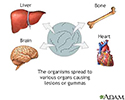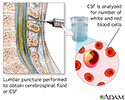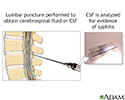Syphilitic aseptic meningitis
Meningitis - syphilitic; Neurosyphilis - syphilitic meningitis
Syphilitic aseptic meningitis, or syphilitic meningitis, is a complication of untreated syphilis. It involves inflammation of the tissues covering the brain and spinal cord caused by this bacterial infection. These tissues are called the meninges.
Causes
Syphilitic meningitis is a form of neurosyphilis. This condition is a life-threatening complication of syphilis infection. Syphilis is a sexually transmitted infection.
Syphilitic meningitis is similar to meningitis caused by other germs (organisms), but it doesn't develop as quickly.
Risks for syphilitic meningitis include a past infection with syphilis or other sexually transmitted illnesses such as gonorrhea. Syphilis infections are mainly spread through sex with an infected person. Sometimes, they may be passed by nonsexual contact.
Symptoms
Symptoms of syphilitic meningitis may include:
- Changes in vision, such as blurred vision, decreased vision
- Fever
- Headache
- Mental status changes, including confusion, decreased attention span, and irritability
- Nausea and vomiting
- Stiff neck or shoulders, muscle aches
- Seizures
- Sensitivity to light (photophobia) and loud noises
- Sleepiness, lethargy, hard to wake up
Exams and Tests
Your health care provider will perform a physical exam. This may show problems with the nerves, including nerves that regulate eye movement.
Tests may include:
- Cerebral angiography to check blood flow in the brain
- Electroencephalogram (EEG) to measure electrical activity in the brain
- Head CT scan
- Spinal tap to obtain a sample of cerebrospinal fluid (CSF) for examination
- Serum VDRL or serum RPR (used as a screening test for syphilis infection)
If screening tests indicate a syphilis infection, more tests are done to confirm the diagnosis.
Treatment
The goals of treatment are to cure the infection and stop symptoms from getting worse. Treating the infection helps prevent new nerve damage and may reduce symptoms. Treatment does not reverse existing damage.
Medicines likely to be given include:
- Penicillin or other antibiotics (such as tetracycline or erythromycin) for a long time to make sure the infection goes away. It is typically given initially using the intravenous route.
- Medicines for seizures.
Outlook (Prognosis)
Some people may need help eating, dressing, and caring for themselves. Confusion and other mental changes may either improve or continue long-term after antibiotic treatment.
Late-stage syphilis can cause nerve or heart damage. This can lead to disability and death.
Possible Complications
Complications may include:
- Inability to care for self
- Inability to communicate or interact
- Seizures that may result in injury
- Stroke
When to Contact a Medical Professional
Go to the emergency room or call 911 or the local emergency number if you have seizures.
Contact your provider if you have a severe headache with fever or other symptoms, especially if you have a history of syphilis infection.
Prevention
Proper treatment and follow-up of syphilis infections will reduce the risk of developing this type of meningitis.
If you are sexually active, practice safer sex and always use condoms.
All pregnant women should be screened for syphilis. Also, people at increased risk for getting syphilis should be screened for it. Common examples include men who have sex with men, people with HIV infection, young adults, and people with a history of incarceration, sex work, military service or illicit drug use.
References
Dionne JA, Ghanem KG. Syphilis. In: Goldman L, Cooney KA, eds. Goldman-Cecil Medicine. 27th ed. Philadelphia, PA: Elsevier; 2024:chap 295.
Hasbun R, van de Beek D, Brouwer MC, Tunkel AR. Acute meningitis. In: Bennett JE, Dolin R, Blaser MJ, eds. Mandell, Douglas, and Bennett's Principles and Practice of Infectious Diseases. 9th ed. Philadelphia, PA: Elsevier; 2020:chap 87.
Radolf JD, Tramont EC, Salazar JC. Syphilis (Treponema pallidum). In: Bennett JE, Dolin R, Blaser MJ, eds. Mandell, Douglas, and Bennett's Principles and Practice of Infectious Diseases. 9th ed. Philadelphia, PA: Elsevier; 2020:chap 237.
US Preventive Services Task Force website. Syphilis infection in nonpregnant adolescents and adults: Screening. www.uspreventiveservicestaskforce.org/uspstf/announcements/final-recommendation-statement-screening-syphilis-infection-nonpregnant-adolescents-and-adults. Updated September 27, 2022. Accessed November 9, 2024.
Meninges of the brain - illustration
Meninges of the brain
illustration
Meninges of the spine - illustration
Meninges of the spine
illustration
Central nervous system and peripheral nervous system - illustration
Central nervous system and peripheral nervous system
illustration
Primary syphilis - illustration
Primary syphilis
illustration
Syphilis - secondary on the palms - illustration
Syphilis - secondary on the palms
illustration
Late-stage syphilis - illustration
Late-stage syphilis
illustration
CSF cell count - illustration
CSF cell count
illustration
CSF test for syphilis - illustration
CSF test for syphilis
illustration
Review Date: 8/29/2024




















